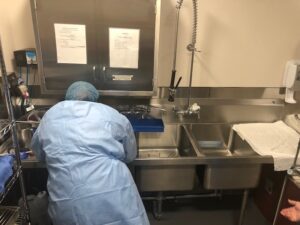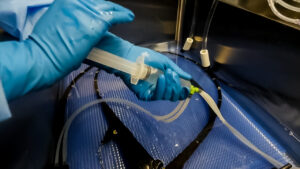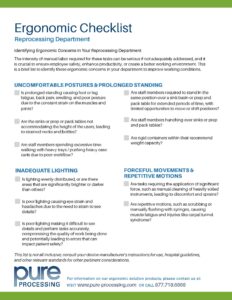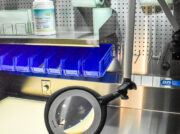
How to Identify Ergonomic Concerns in Your Reprocessing Department
If you have worked in a reprocessing department, it is likely that you have experienced discomfort, decreased productivity, or even injury due to poor ergonomics. The Occupational Safety and Health Administration (OSHA) defines ergonomics as “fitting the job to the person” rather than “fitting the person to the job.” Although this definition can be complex, it is essential to understand why ergonomics plays a critical role in reprocessing departments.
The intensity of manual labor required for reprocessing tasks can be serious if not adequately addressed, and it is crucial to ensure employee safety, enhance productivity, or create a better working environment. In this blog post, we will discuss how to identify these ergonomic concerns in your department.
Concern #1. Uncomfortable Postures
Uncomfortable postures are common during the reprocessing of medical instruments, as workers often perform repetitive actions in strained  positions. Staff members may be hunched over sinks or prep and pack tables while manually cleaning or reaching too far for tools or materials at a prep & pack table. Performing these types of movements frequently can lead to musculoskeletal disorders if sinks and tables are unable to accommodate the height of the users. Many sinks also have deep basins, which are not conducive to manual cleaning and can cause lower back, shoulder, and neck pain.
positions. Staff members may be hunched over sinks or prep and pack tables while manually cleaning or reaching too far for tools or materials at a prep & pack table. Performing these types of movements frequently can lead to musculoskeletal disorders if sinks and tables are unable to accommodate the height of the users. Many sinks also have deep basins, which are not conducive to manual cleaning and can cause lower back, shoulder, and neck pain.
Concern #2. Prolonged Standing
Prolonged standing can cause significant discomfort for technicians and nurses, as they are often required to stand in the same position over a sink basin or prep and pack table for extended periods of time. This can lead to foot, leg, knee, or hip fatigue, as well as back pain, which can become chronic if not adequately addressed. Extended standing can also lead to decreased blood flow to the legs, causing swelling and discomfort. In addition, standing in the same spot or area for long hours can lead to poor posture, which can contribute to musculoskeletal disorders over time.
Concern #3: Forceful movements and repetitive motions
Strained or difficult movements and repetitive motions are also common in reprocessing departments. Some tasks require applying substantial  force, such as the manual cleaning of heavily soiled or narrow instruments, which can lead to strains and sprains. Repetitive motions, such as scrubbing instruments or using syringes when manually flushing, can lead to muscle fatigue and injuries such as carpal tunnel syndrome, which may result in missed shifts and staffing challenges.
force, such as the manual cleaning of heavily soiled or narrow instruments, which can lead to strains and sprains. Repetitive motions, such as scrubbing instruments or using syringes when manually flushing, can lead to muscle fatigue and injuries such as carpal tunnel syndrome, which may result in missed shifts and staffing challenges.
Concern #4. Inadequate Lighting
Inadequate lighting can cause a range of issues for nurses and technicians working in sterile processing or gastroenterology departments. Poor lighting can cause eye strain and headaches, which can result in decreased productivity and reduced accuracy in completing tasks. Additionally, it can make it difficult to see fine details. Debris, and damage to instruments, which can compromise the quality of the work being done. An inability to visually identify these issues can not only lead to extra work in the form of returned trays but can also patients at unnecessary risk.
Conclusion
Although no one sterile processing or gastroenterology is the same, many departments varies, many departments share similar opportunities to enhance ergonomics. A comprehensive ergonomic assessment can help identify your ergonomic pain points and address concerns and give your team the best working conditions to achieve a high quality of work.

Downloading our ergonomics assessment checklist for your department can help ensure that your department is on the right track to ergonomic success.





